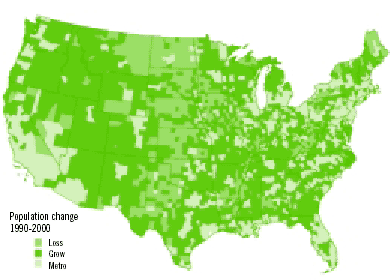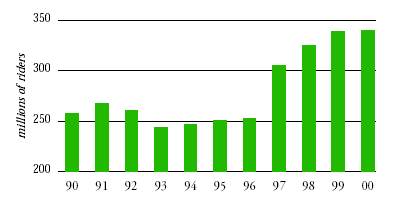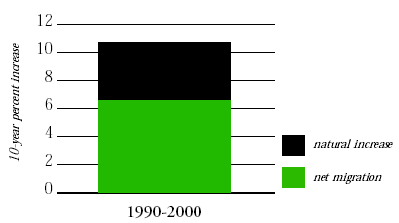Download in Adobe PDF Format
The need for better mobility and access in small urban and
rural communities is placing new emphasis on the availability
of public transportation services, which have become essential
both to sustain and guide the growth in flourishing areas, and
to revitalize areas that continue to struggle.
Regardless of their current economic fortunes, small urban
and rural communities often lag behind in adequate public
transportation. Nearly two-thirds of all residents in these
communities have few if any transportation options:
This is an extraordinary hardship for the millions of
car-less households and nondrivers who reside in
non-metropolitan America. The lack of transit options puts
low-income families, especially, at a tremendous disadvantage
economically. Middleincome Americans spend less than 22
percent of their annual incomes on private transportation;
however, Americans in the lowest 20 percent income bracket,
many of whom live in rural settings, spend about 42 percent of
their total annual incomes on transportation. (2)
Today, there is a renaissance underway in public
transportation that extends well beyond our major metropolitan
areas. In small urban and rural communities nationwide, there
is a growing recognition of the broad-ranging benefits of
public transportation:
-
Greater freedom and independence to live and work in a
variety of settings
-
More choice in how we travel and how we use valuable time
and money
-
. Greater access to varied daily destinations
-
Enhanced opportunity for individuals, families,
businesses and industry
While great strides have been made in the last decade to
provide more tranportation choices, more support is needed in
small urban and rural communities. Capturing these benefits in
the years ahead will require continued innovation, significant
increases in transit investment and broad support from
political and community leaders.
The Changing Face of Rural America
Small urban and rural America is now home to 56 million
residents in 2,303 non-metropolitan counties, as well as 35
million more residents living in rural settings on the fringes
of metropolitan areas. (3)
In the 1990s, millions of Americans moved to
non-metropolitan areas, lured by the quality of life and the
creation of new jobs relocated from urban centers. This shift
has contributed to a ten-percent population increase in small
urban and rural communities, nearly three-quarters of which
are still growing. (4)
Growing Environmental, Traffic Concerns
While small urban and rural communities may provide an
improved lifestyle, many are beginning to face dilemmas common
to major metropolitan regions, including declining air quality
and increasing roadway congestion.
Traffic congestion in small urban and rural areas is
increasing 11 percent per year—twice the rate in urban areas.
(5)
The overall number of Americans living in areas with
substandard air quality will increase seven percent by 2009,
spreading the air-quality burden increasingly across small
urban and rural as well as urban areas.
Figure 1
Non-metropolitan Population Change

Three-quarters of America’s non-metro counties continue
to grow.
CTAA, Full Steam Ahead for Reauthorization
The looming threat of congestion and declining air quality
is often most dramatic in small urban and rural areas that
serve as gateways to the nation’s most attractive natural
resources—our national parks, forests and preserves. Where
these areas are threatened, public transit is increasingly
being called on to enhance access while reducing environmental
damage.
Support for Innovative Transit Programs
Should be Expanded
As a result of their new challenges, small urban and rural
areas have become wellsprings of innovation in public
transportation — despite recurrent funding constraints and
longstanding programmatic restrictions. In several areas,
innovative and effective transit programs have been launched,
but greater investment will be needed to broaden their
application to more small urban and rural communities.
|
Through the Federal Job Access and Reverse Commute
Program authorized under TEA 21, nearly 400 new,
innovative services have been introduced in every state
in the nation, benefiting the population in small urban
and rural communities.
CTAA, Job Access and Reverse Commute,
www.ctaa.org/ntrc/atj/jarc/BriefHistory.asp |
For example, in the Savannah, GA region, Chatham Area
Transit is reconstituting itself as a "mobility enterprise"
that coordinates services across a multi-county, bi-state
area. Reversing long-standing fragmentation in service
delivery, the restructuring was the result of a reexamination
of the agency’s mission and role in the face of growth and
development challenges and a widening geographic scope of
travel. (6)
Other innovative programs providing access for seniors,
human services, jobs, education and other needs include:
Lifeline for Seniors
-
The Central Arkansas Development Council works with south
central Arkansas communities to provide transportation
services to the impoverished Lower Arkansas Region. The
coalition serves 10 counties using fixed-route and
demand-responsive services and pays for transit services for
its elderly customers with grants and foundation funds.(7)
-
In Harris County, TX, taxi operators assist seniors by
providing Medicaid transportation, ADA paratransit, and
other contract services for transit agencies. A countywide
user-side subsidy program utilizing taxis is under
development. (8)
Access to Healthcare
-
In the Mitchell, SD area (pop. 14,558), local communities
created public transportation alternatives that expanded
access for medical treatment and reduced healthcare costs by
reducing in-patient medical treatment and the costs of 911
responses and the use of Emergency Medical Services. (9)
-
Partnering in the delivery of small urban and rural
transit services has been a focus of attention in North
Carolina since 1977, when the first state-level, interagency
coordinating council was formed. Today, coordination of
human service and general public transportation services
through jointly developed plans is a prerequisite for state
funding, and coordinated services are available across each
of North Carolina’s 100 counties. (10)
Enabling Opportunities in Jobs and Education
-
In Alabama, small urban and rural communities use state
and county vehicles, including school buses, to provide
access to jobs or other services. The buses, which already
stop in residential areas, connect recipients with a central
location from which they can access training, employment and
transportation options at other sites.(11)
Figure 2
Growth of Transit Ridership in Small Urban and
Rural Areas

The nationwide resurgence in public transit includes
continued growth in ridership on today’s small urban and rural
services—up by 32% since 1990. Through TEA 21, transit is
making a difference in America’s heartland.
American Public Transportation Association, 2002 Public
Transportation Fact Book
-
Implementing a job-access transit program, Winchester, VA
(pop. 23,585) and the Winchester/Frederick County Economic
Development Commission expanded access to thousands of
manufacturing jobs in the area that are tailored to the
specific work shifts of area employers. (12)
In addition to these wide-ranging benefits, expanded and
enhanced public transportation provides essential connections
between small urban and rural communities and the entire
regional and national transportation network of intercity
buses, regional and national rail service and the nation’s air
passenger system.
Figure 3
Non-metropolitan Demographic Change

The 1930s is the only other decade besides the 1990s
that experienced small urban and rural population increases in
all population categories.
CTAA, Full Steam Ahead for
Reauthorization
Figure 4
Small Urban and Rural Investment
Requirements

AASHTO and APTA have estimated rural and small urban
transit investment needs at approximately $1 billion per year
over the next six-year reauthorization period.
CTAA, American Public Transportation Association,
Transit Program Historic Funding Levels
Increasing Transit Investment Will Pay
Off
The transit innovations emerging in small urban and rural
America represent new models for providing expanded and more
cost-effective mobility. If service expansion and continued
innovation are to be broadened and sustained, however, major
increases in long-term funding are essential.
In the months ahead, local, state and national elected
officials will have a unique opportunity to expand the reach
and quality of public transportation across small urban and
rural America through reauthorization of the Transportation
Equity Act for the 21st Century—TEA 21. The needs—as well as
the payoffs—are compelling for America’s heartland communities
and residents.
For more information on how to communicate the
extraordinary value of transit in small urban and rural
America, contact your:
-
Local transit and human service agencies
-
State Departments of Transportation
-
State transit associations
-
The American Public Transportation
Association
|
The U.S. Department of Health and Human Services
acknowledges the importance of public transportation for
job access in small urban and rural areas.
U.S. Department of Health and Human Services, Office
of Planning, Research, and Evaluation of the
Administration for Families (ACF), Transportation in
Rural Communities: Strategies for Serving Welfare
Participants and Low-Income
Individuals |
Works Cited
-
Community Transportation
Association (CTAA) Research Center— National Statistics,
www.ctaa.org/ntrc/is_rural.asp
-
The Bureau of Transportation
Statistics, Consumer Expenditure Survey, Transportation
Statistics Annual Report, 2000, www.bts.gov
-
The Rural Rebound: Recent
Nonmetropolitan Demographic Trends in the United States,
www.luc.edu/depts/sociology/johnson/p99webn.html
-
The Rural Rebound
-
CTAA, Full Steam Ahead for
Reauthorization, www.ctaa.org/data/reauthorization_
strategy.pdf
-
TCRP Project J-8B, New Paradigms
for Local Public Transportation Organizations, case study
material
-
U.S. Department of Health and Human
Services, Office of Planning, Research, and Evaluation of
the Administration for Families (ACF), Transportation in
Rural Communities: Strategies for Serving Welfare
Participants and Low-Income Individuals, Rural Welfare Issue
Brief, Rural Welfare to Work Strategies Initiative,
www.macroint.com/publications/transpo2.pdf
-
Multisystems Consulting, Transit
Trends, The Newsletter of Multisystems Consulting, 2002
-
Transportation in Rural
Communities: Strategies for Serving Welfare Participants and
Low-Income Individuals
-
North Carolina Department of
Transportation, Public Transit Division Transit program
documentation
-
Transportation in Rural
Communities: Strategies for Serving Welfare Participants and
Low-Income Individuals
-
Transit Trends
Other Sources
American Association of State Highway and Transportation
Officials and American Public Transportation Association,
Money at Work: TEA-21 in Action, October, 2001
American Public Transportation Association, Transportation
Partnership for Tomorrow, Public Transportation—Wherever Life
Takes You information kit
APTA Transit News, "APTA Honors Innovative Welfare to Work
Programs," Jan. 31, 2002,
www.apta.com/news/releases/wtowawards.html
American Public Transportation Association, 2002 Fact Book,
53rd edition, February 2003
Community Transportation Association (CTAA) Federal
Flashes, "President Bush Proposes Record Spending for FY2003,"
Feb. 6, 2002, www.ctaa.org/fednews/flashes/20020206.html
CTA Magazine, "Loudon County Transportation Keeps Pace,"
July/August 2002, www.ctaa.org/ct/julyaug00
FTA Livable Communities Initiative, Building Livable
Communities with Transit,
www.fta.dot.gov/office/planning/lc/livable.pdf
National Cooperative Highway Research Program/TRB/National
Research Council, Community and Social Benefits of
Transportation Investment, NCHRP Project 8-36, Task 22,
"Demonstrating Positive Impacts of Transportation
Investment"
The Surface Transportation Policy Project (1991-2001), Ten
Years of Progress: Building Better Communities Through
Transportation, November 16, 2001, p. 26, "Treasure Valley
Community Partnership,"
www.transact.org/tenyears/fullreport.htm
Time, "The Great Escape," December 8, 1997
Transportation Equity Act for the 21st Century—TEA-21,
Moving Americans into the 21st Century,
www.fhwa.dot.gov/tea21/h2400iii.htm
Welfare Information Network: Vol. 2, No. 10, June 1998,
www.welfareinfo.org/transitneed.htm
1990 Census of Population data, calculated by ERS,
"Comparison of rural/urban and metro/non-metro residency
patterns," www.ers.usda.gov/briefing/rurality/WhatisRural/
Research:
Cambridge Systematics Inc.
Editing, design and production:
Reichman Frankle
Inc.




